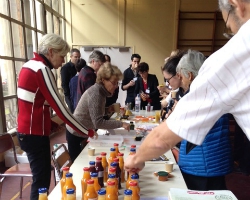Food for the elderly gets a total makeover
A nutritious, appetising dish is the result of its chemistry, biology and processing combined with the diner’s tastes and needs. As elderly people present a special set of requirements, the OPTIFEL(opens in new window) (Optimised food products for elderly populations) project has translated seniors’ nutritional needs, food preferences and physical capacities to a precise set of specifications for a range of foods based on fruit and vegetable products. Catherine Renard, coordinator of OPTIFEL explains ‘The aim of OPTIFEL is to fight the onset of elderly malnutrition by achieving a paradigm shift: rather than remedying elderly nutritional deficiencies, the project will contribute to fight appetite loss with attractive and nutrient-dense food products.’ Food science application Purées are an excellent way of providing optimal nutrition while being easy to digest. OPTIFEL used sensory and preference trials to collect improved knowledge of factors that modulate the texture of purées, allowing texture adaptation based on particle size and pH for product stabilisation and nutritional value. Insoluble plant protein particles added to the carrot-based purées makes them difficult to process industrially, but much easier to eat as they are more coherent. Results revealed points for future processing. Vitamin content was less affected than expected by reheating and warm-holding in food preparation due to low oxygen availability in the food. However, results from an innovative technology, high hydrostatic pressure stabilisation showed apple products lost most of their vitamins C and B9 during the shelf-life, despite low temperature storage. Food safety is paramount and OPTIFEL results indicate that the cold chain must be maintained during production, storage and distribution. Moreover, as Catherine Renard explains ‘Even though vegetative cells are destroyed by reheating according to safety rules used in retirement homes, it is not the case with toxins such as cereulide that cause nausea and vomiting. Reheating at home is still a major question.’ Tailored to elderly needs Specific requirements for the elderly included ‘establishment of a preference scale for fruit and vegetables by seniors, which can be used for example in menu planning,’ says Catherine Renard. ‘Hand-grip strength is an adequate proxy for mastication strength and, together with complementary information on dental status, can be used to predict eating capability.’ Other tools include the Personalised Nutritional Calculator(opens in new window) developed by partner Centiv GmbH so nursing homes can calculate the nutritional needs of the elderly on a personalised level. Types of packaging also came under scrutiny and tests analysed strength needed for opening of food containers. The recipes Tantalising recipes can be found on the Recipes section(opens in new window). Fortified with veal, chicken stock and milk, the OPTIFEL fortified carrot and potato purée is just one example. Particularly successful was the range of vitamin and mineral-enriched smoothies. The apple smoothie includes rose juices and blueberry and the concentrated vegetable soup was based on carrot and parsley. The SME partner Christian Potier has continued development of the product range and is now in commercial negotiation. For smoothie products, a different market may be more appropriate and this is under discussion. For the future, Catherine Renard stresses that ‘There is still a high level of ongoing scientific knowledge production from project work. Elderly people, their families and caregivers are not the only beneficiaries of OPTIFEL research results. SMEs will continue to develop products suitable for this niche market aided by collaboration with the project: scientific and trial data is being translated into new know-how for food production.’







